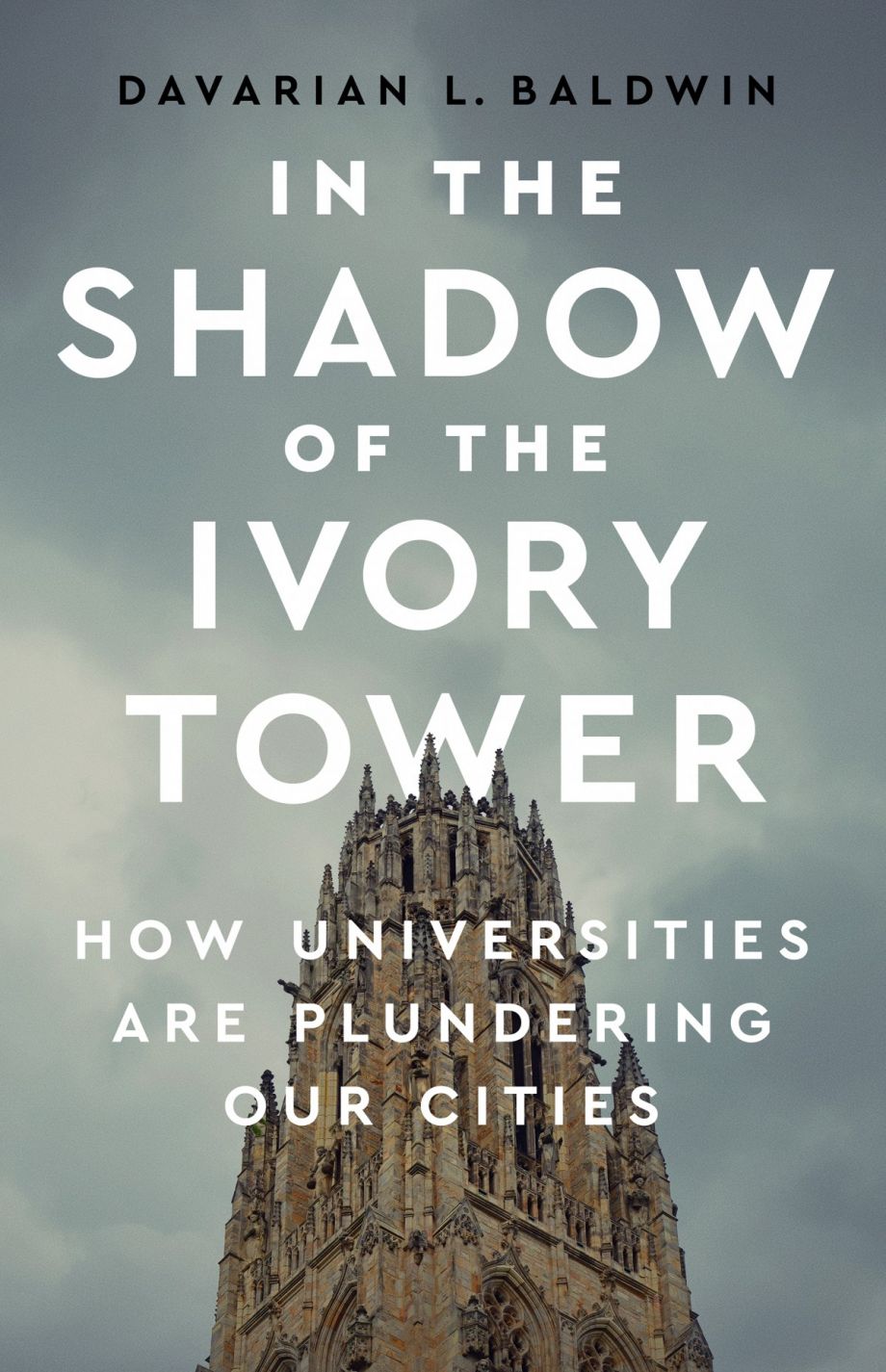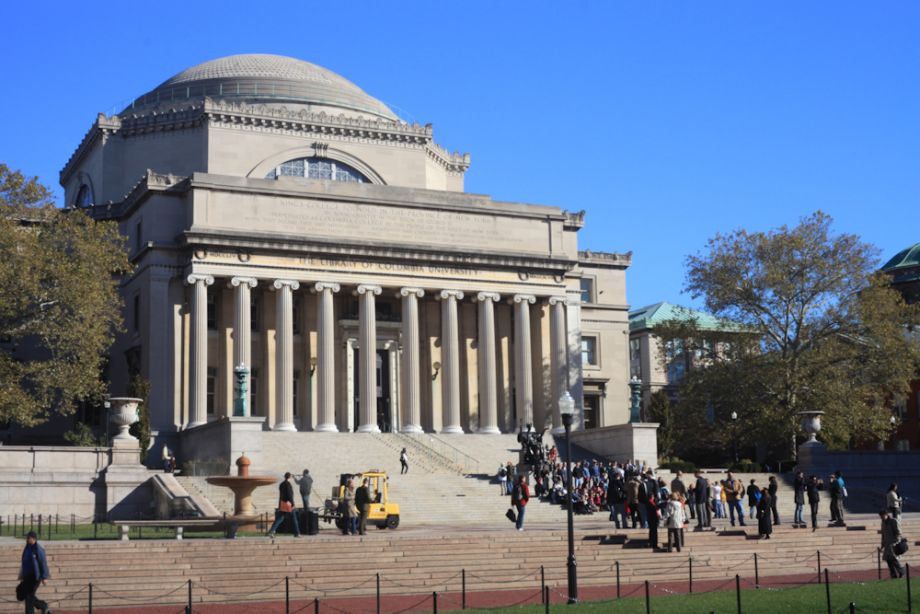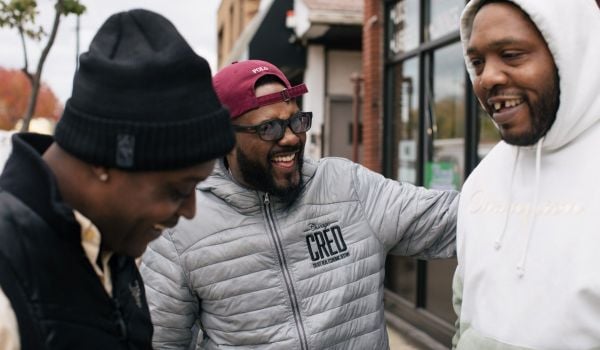This article has been excerpted from In the Shadow of the Ivory Tower: How Universities Are Plundering Our Cities by Davarian L. Baldwin. Copyright © 2021. Available from Bold Type Books, an imprint of Perseus Books, LLC, a subsidiary of Hachette Book Group, Inc.
I never thought a university would foretell the future of our cities. But there I was, on a December afternoon in 2003, stepping out into the brisk South Side air after hours holed away in the University of Chicago’s Regenstein Library. I immediately heard chants of protest and saw people buzzing about. So I followed the sound over to the main quadrangle, just outside the university’s administration building. There I saw a crowd of about fifty people surrounded by media crews and onlookers. On one side stood residents from the historic Black neighborhood of Bronzeville, alongside students and others chanting “U of C, look at your history!” while holding signs that read “Support the Checkerboard Lounge in Bronzeville.” And on the other side, university officials listened, mostly playing defense, with a silent chorus of furrowed brows.
The famed Checkerboard Lounge had been a cultural mainstay of Bronzeville, a “blues shrine” that had stood on 43rd Street since 1972. The lounge needed restoring, but instead of providing funding, the university put together a plan to relocate the lounge from its original spot to a university-owned building inside the Hyde Park neighborhood’s Harper Court shopping district. Outraged, Restoring Bronzeville advocates immediately charged UChicago with “cultural piracy.” For decades the city had turned its back on Bronzeville, but things were slowly changing, largely because of the sweat equity of local advocates working to turn things around.

Of course, the university had a much different take on the story. School administrators and local stakeholders for the Hyde Park campus neighborhood argued that the Checkerboard acquisition was a simple economic transaction between owner and buyer. UChicago officials also explained that the relocation was an act of Black historic preservation. At the time, Sonya Malunda was the senior associate vice president for Civic Engagement at the university. She rejected any suggestion that UChicago did anything wrong in the acquisition. In fact, the lounge owner, L. C. Thurman, got on a bullhorn at the December rally and told the protestors to go home. “A lot of myths surrounding the Checkerboard became the narrative,” Malunda explained. School officials were responding to the closing of the lounge because of building code violations and considered the relocation a mutual benefit to the university and the community. She still looks back with frustration on that chapter in her life: “We wanted to do the right thing, but it seems no good deed goes unpunished.”
“I think that’s complete bullshit” is how Bernard Loyd responded to Malunda’s account. As he saw it, the university identified the Checkerboard Lounge as a key attraction for the Hyde Park campus neighborhood … and for no one else. He pointed out that the Harper Court shopping and entertainment district, where the Checkerboard would sit, was being renovated because there was hardly anything to do in Hyde Park. “Students were coming to the Checkerboard,” he exclaimed. In 2003 Loyd was working as a high-end consultant at the downtown business- management firm McKinsey and Company. And there was one moment during the December protest when things got tense and he and Malunda squared off in a testy shouting match. As Loyd told me the story, I wondered how this corporate executive became such a feisty Bronzeville community activist waging battle with the university.
Loyd didn’t even grow up on the South Side, but he brought his broad perspective to the Checkerboard controversy. He was born to a white German mother and an African American military vet from Chicago, by way of Louisiana. I could still hear a German inflection in his voice while he explained why the Checkerboard meant so much to him. Loyd had lived with his mother in Liberia before going to school at MIT. After graduation he served on the school’s board of trustees while living in the neighborhoods that Harvard and MIT targeted for campus expansion. “Town-gown friction is not new to me,” he explained. Loyd saw how higher education institutions worked from the inside. This knowledge of town-gown—or the city and its schools—proved critical when he moved to Chicago’s South Side.
Very few corporate executives working for white-shoe firms like McKinsey look for housing on the South Side and definitely not in the hardscrabble blocks of Bronzeville. But Loyd went there anyway, and in 1993 he purchased what he described as a “shell of a home” on 43rd and King Drive. He said one of the things that kept him in the neighborhood was the Checkerboard Lounge. Just two hundred feet from Loyd’s porch steps stood the place known as “Home of the Blues.” Blues great Buddy Guy and local small-business owner L. C. Thurman opened the Checkerboard in 1972. And its “nicotine-hued wall of fame” held many stories about impromptu jam sessions that included Muddy Waters, the Rolling Stones, Eric Clapton, Junior Walker, and KoKo Taylor, just to name a few. Long after blues’ popular appeal faded, university students, suburbanites, and both local and international tourists still came to pray at the altar of this “blues shrine.” As Loyd told me, “Anybody and everybody would trickle into the Checkerboard … and I was one of them.”
The city shut down the lounge for what was essentially a problem with the roof. And Loyd had even met with Thurman to address what he considered an easy fix. But he couldn’t believe how quickly the public story became “the University of Chicago is going to ‘save’ the Checkerboard by moving it south to Hyde Park.” Loyd knew something else was going on. When he met with UChicago officials, such as Vice President of Community and Government Affairs Hank Webber, they told him the university was very interested in preserving a community landmark by finding a “mutually agreeable location.” And Loyd believed the best solution was to save the Checkerboard in its original location, within its historic cultural context. But when asked about that solution, Webber told the press, “We don’t make grants to for-profit institutions.”
As a business consultant, Loyd then wondered why UChicago was willing to renovate a building for free and rent space to the Checkerboard at less than half the market rate in Hyde Park. He certainly didn’t blame Thurman for taking such a sweetheart deal. But if the university was so invested in preserving a historic landmark, why not do it in Bronzeville? He believed that UChicago saw the steady stream of students and faculty going to the lounge and wanted that kind of magnetic pull for its own “entertainment district” in Hyde Park. A thriving campus neighborhood draws students and faculty while redirecting investment dollars and new residents to the city. Loyd saw that grabbing the Checkerboard “helped the university increase the allure of Hyde Park as a profitable destination.” But what about Bronzeville?
UChicago’s chess moves on the Checkerboard Lounge were about much more than a simple neighborhood squabble. The Checkerboard controversy points to a new reality affecting anyone who cares about urban America. Higher education exerts an increasingly powerful hold over our cities and those who struggle to survive in its shadows. Schools have become the dominant employers, real estate holders, health-care providers, and even policing agents in major cities across the country. And the lower-income neighborhoods and communities of color that stand in the immediate path of campus expansion, while in deep need of new investments, are left the most vulnerable. These residents face increased housing costs or even displacement amid university land developments. Many of the same Black and brown urbanites also toil in the low-wage sectors of the higher education workforce as groundskeepers and food service staff. And they often endure violence and surveillance from campus police forces.
Those in the immediate shadow of the ivory towers have long been the first to experience the consequences of the entangled relationship between higher education and urban life, or what I call the rise of UniverCities. But the story here is bigger than campus neighborhoods. The growing influence of these schools on entire cities solidifies their political authority over housing costs, labor conditions, and policing practices for everyone living in urban America.
When most of the United States had abandoned cities in the mid-twentieth century, higher education was one of the only institutions that remained. A core group of colleges and universities used public urban renewal money to bunker themselves behind the walls of campus buildings or demolished city blocks—and away from the growing “invasion” of Black and Latinx residents. But starting in the 1990s, young professionals, empty nesters, and the children of suburban sprawl began to seek a more urbane lifestyle. And municipal politicians and real estate developers from different cities started competing with one another to capture the potentially lucrative new tax base and its consumer dollars. At the same time, colleges and universities were looking for new revenue streams in the face of tight state budgets. The interests of university and city leaders converged when the college campus was reimaged as the palatable and profitable version of a safe urban experience.
The university has shifted from being one small, noble part of the city to serving as a model for the city itself. It is precisely the commercial amenities associated with “university life”—concerts, coffee shops, foot traffic congestion, fully wired networking, and high-tech research—that are sold today as a desirable urban lifestyle.
In the last two decades a growing body of work has examined what is being called “the university as corporation.” Soaring tuition costs, corporate- funded research, and the for-profit push of online learning seem to signal the death of the university as we knew it. The “university-as-corporation” scholarship is insightful for highlighting the shift in higher education policy from public good to private profits. However, we must move beyond campus walls to understand the full impact of universities.
A much smaller group of thinkers and activists has started to detail the recent history of universities as engines of “smart growth,” driving the urban economy. But it’s time to bring this story to the present and explore university-driven city building on a national scale, from the small private liberal arts college to the large public research university.
When Richard Florida introduced us to the “creative class,” many dying cities could finally see a future after the fall of factories. Florida prophesied that innovations produced in hospitals, laboratories, tech start-ups, and design studios would power the economic rebirth of cities. He explained that in order to attract creative types, cities must redesign their landscape around a “street level culture” that blurs the lines between work and play. Florida has recently pulled back on his grand claims about the creative city, admitting that the increased settlement of creative types can actually heighten inequalities. But all across the country, urban stakeholders are still scrambling to build a creative city with a dynamic array of lofts and workstations adorned in glass and steel facades that spill out onto a teeming blend of cafés, galleries, bookstores, and street life.
Not surprisingly, this creative landscape sounds a lot like a campus. In fact, Florida marked urban universities as a “central hub institution of the knowledge economy” that can help revitalize cities and attract the creative class. But again, the urban realities of town-gown relations mean that many people are left out of the “public” that benefits when the private interests of colleges, universities, and their medical centers chart the course of struggling cities. We must rethink the uncritical celebration of “creative cities” by prioritizing desperate urban issues, from affordable housing and health care to equitable policing and living wages. And the growing influence of the knowledge economy means that universities will play a central role in creating equitable and just cities.
Postscript: On November 18th of 2005, the “New Checkerboard Lounge for Blues ‘n’ Jazz” opened to great fanfare and all of Hyde Park was patting itself on the back for such a wonderful “acquisition.” However, the Checkerboard became a casualty of the university life urban plan. Stripped of its Bronzeville context, the lounge made little sense in Hyde Park. Ultimately it closed in 2015, due to low customer turnout.
_200_200_80_c1.jpg)
Davarian L. Baldwin is a leading urbanist, historian and cultural critic. The Paul E. Raether Distinguished Professor of American Studies and founding director of the Smart Cities Lab at Trinity College, Baldwin is the author of Chicago's New Negroes: Modernity, the Great Migration, and Black Urban Life and coeditor, with Minkah Makalani, of the essay collection Escape from New York! The New Negro Renaissance Beyond Harlem.















